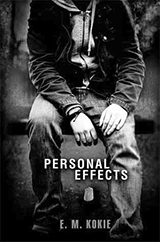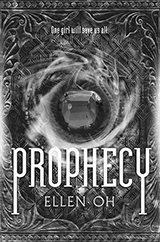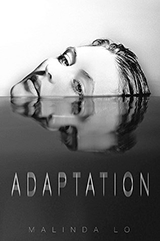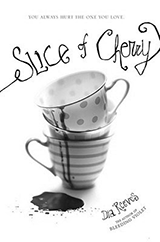ALAN v40n3 - The Author's Connection: Someone Like Me
The Author's Connection: Someone Like Me

I play “Spot the Asian” when I watch movies. I remember doing this for The Avengers recently, and feeling disheartened near the end of the film when I had yet to see an Asian American face on the big screen. The movie redeemed itself in a montage of postconquering- the-bad-guys scenes in New York City, where I saw Asian faces as extras in the background and even a brief cameo of an excited Asian American boy with actual lines to speak. For those who are not people of color (PoC), this might seem an odd ritual, but imagine growing up and rarely seeing someone who looked like you in the media—not even in commercials, much less on television shows, in films, or in magazines. I was a voracious reader as a child, but it was only as an adult, looking back, when I realized that I had never read a book with a character who looked like me.
Imagine if you were a woman, and the television shows and commercials you saw only had men in them, that all the models in the magazines you read were men, that if you actually saw a woman reflected back at you from the screen or the page, it stood out so much that you’d make a mental note of it. You would feel surprised and pleased. Look , you would think, someone like me . You would remember the television show or the product being sold as something positive, something you should keep an eye out for.
Because everywhere else in the media, you were rendered invisible.
Malinda Lo and I set up the Diversity in YA tour back in May of 2011 because both of our Asiani-inspired YA fantasies were published within weeks of each other. We wanted it to be a celebration of diversity in young adult books and to continue the dialogue that had already been brewing among readers, librarians, educators, and those who worked in publishing. I remember quite vividly our panel at the Cambridge Public Library in Cambridge, Massachusetts, moderated by Roger Sutton from The Horn Book Magazine , when a woman raised her hand during the Q&A portion and asked why diversity mattered. Her children, she said, were half white and half Chinese, and they read books with no Chinese characters in them and loved them. It wasn’t their ethnicity or backgrounds that mattered, she asserted. A good book was a good book.
There was a moment of stunned silence. We were at a Diversity in Young Adult books panel, after all. I was the only one who responded to her question, saying that it was true that if an author did her job, readers should be able to relate to the character no matter how dissimilar their backgrounds or experiences might be. However, I had no choice in the fact that I only saw white characters in books while I was growing up. Of course, it was only after the panel that the response I wished I had given came to me. (Isn’t it always like that?!) If a character’s background and ethnicity did not matter, if only good books mattered, then why didn’t we have stories featuring more non-white characters out there on the shelves?
Reading about white characters was the norm for me as a child. Should it remain the norm, given the increasingly diverse populations in the United States today? Shouldn’t the bookshelves be reflective of the multicultural populations that make us who we are?
Almost two years after the Diversity in YA tour, it is quite clear to me that the topic is still very much on people’s minds. In December 2012, the New York Times published an article titled “For Young Latino Readers, an Image Is Missing” about the lack of representation in children’s books with Latino characters. I would say this issue extends to all children of color. In the same month, YALSA’s The Hub published a blog post lamenting the lack of characters of color on young adult book covers. This was not the first of such blog posts to crop up in recent years.
My intention is certainly not to make light of the issues of whitewashing in young adult book covers (when a character of color’s ethnicity is changed to white or obscured), but the issues are deeper and more problematic than at first glance. The fact of the matter is that the number of young adult books published each year featuring a main protagonist of color is still very low. As the only YA novel that came out in 2009 showcasing an Asian heroine boldly on its cover, my debut Silver Phoenix was different , simply by virtue of that fact. The novel stood out because there were so few young adult Asian-inspired fantasies or books with main Asian protagonists. Period. Even now, I can count the number on one hand.
And for all the talk about seeking different and original stories in publishing, it only takes one glance at the monochromatic covers on the young adult shelves to see the truth of the matter. Whitewashing book covers is never okay, but it is easier to do when it is only happening to a few books—because the vast majority of other books feature no characters of color. It is something that, despite causing an uproar online in pockets of certain communities, can still be swept under the rug and soon be forgotten.
There is also the rather sad notion that when you feature a protagonist of color on the cover, the majority of white readers will bypass the book, thinking it isn’t “for them.” Is this conjecture or fact? I have no easy answers, but I will say that for every reader I’ve had who told me she picked up my novel because she loved Asian culture or manga or anime, there has been one who expressed surprise that she loved Silver Phoenix —because she wasn’t at all “into” Asian culture.
As an author who just wanted to tell a good story, these types of responses are frustrating. Because my books are the rarity rather than the norm, and because I am also in the minority as a published Asian American author in the field, my books and I are forced to represent whether we want to or not. I am left to navigate the very difficult task of promoting diversity in books (and yes, this obviously is very important to me) while also trying to get the message across that what I write is fun . What I write are stories filled with magical adventures, and monsters, and cute boys, and falling in love for the first time.
For me, story matters most. And when we get to the tipping point where a non-western fantasy on the YA shelves isn’t automatically seen as different because there are a dozen more to choose from, because it isn’t so unusual to have a young adult novel that features a PoC main character, that is when representation on book covers won’t be so crucial any longer. Because there will be actual representation in the stories–there will be diversity in points of view and voices and experiences. And including characters of color on covers, too, will eventually become the norm rather than the exception.
At the School and Library Journal ’s Day of Dialogue in 2011, author Rita Williams-Garcia said that she wanted to see children’s genre books featuring characters of color—mysteries and science fiction and thrillers. Books that aren’t necessarily dealing with identity or identity crisis, but feature PoC characters simply being teens while saving the world, falling in love, and solving impossible mysteries. I think we are slowly moving toward this reality, although it often feels like painful baby steps.
What can you do as educators, librarians, or simply fans and readers of young adult books? How can you help to ensure a more diverse set of books published for our tweens and teens as we move forward? First, you need to actively seek out these novels to read. Books featuring a main protagonist of color are almost never lead titles, which means that they are less buzzed about by publishers, receive less marketing, and are less often carried in bookstores. Even as a reader who actively wants to support diversity, I have to keep my eyes and ears open for diverse reads.
It is also important to know when to talk about diversity and when to talk about good stories. You might be pitching the same book different ways, depending on what your reader wants and needs. It is a matter of understanding your audience and not just grabbing a book featuring a black protagonist and recommending it only to your black readers. Or thinking the fairy tale that has a lesbian romance is only for LGBTQ or questioning teens. It is true that in retrospect, I realize that I wrote Silver Phoenix because it is a book I wish I could have read as a teen, being a huge fantasy lover. And I appreciate all the Asian American teens who wrote to me to say that they loved my stories. But I didn’t write my novels solely for Asian American readers or those “into” Asian culture. I wrote novels that I hoped any fantasy reader would love.
So, to those of you who want to help diversify young adult books, I ask you to speak about the importance of diversity in novels, about reading widely from your own experiences, then reading widely beyond that. But also recommend diverse books because they are fun and enjoyable books to read, not for their message or lessons or because you believe it would be “good” for the teen reader. You don’t have to wait until Black History Month to talk up or include books with black characters. And please do include diverse titles on lists beyond those focused on diversity so they are not relegated to that singular label.
Resources and Recommendations
The Children’s Book Council Diversity Committee formed last year and is part of the Children’s Book Council. Their focus is on advocating for an inclusive and representative children’s publishing industry and increasing the diversity of voices and experiences in children’s and young adult literature. You can find them at cbcdiversity.com . Members include editors Alvina Ling from Little, Brown Books for Young Readers and Cheryl Klein from Arthur A. Levine Books/Scholastic.
I also wanted to mention Lee and Low Books ( leeandlow.com ), a publisher that focuses entirely on acquiring and publishing multicultural children’s books, from picturebooks through young adult novels. They recently added Tu Books as an imprint. Tu publishes middle grade and young adult fantasy, science fiction, and mystery with protagonists of color; this imprint is headed by Stacy Whitman (who was a founding member of the CBC Diversity committee). Recently, Tu Books released Diverse Energies , a multicultural YA dystopian anthology. It contains my first published short story, “Blue Skies,” which is set in a future Taipei. The two editors, Joe Monti and Tobias Buckell, were inspired to put this anthology together in direct response to the recent surge in popularity of young adult dystopians that often feature a very white and straight future. After reading the contributions by authors such as Ursula K. Le Guin, Paolo Bacigalupi, and Ken Liu, I believe the anthology is wonderful in bringing together points of view beyond the norm..

|

|

|

|

|

|
| Diverse Energies edited by Tobias Buckell and Joe Monti | Beautiful Music for Ugly Children by Kirstin Cronn-Mills | Personal Effects by E. M. Kokie | Prophecy by Ellen Oh | Adaptation by Malinda Lo | Slice of Cherry by Dia Reeves |
| Thank you so much for giving me the opportunity to share my thoughts and speak on a subject that is close to my heart. Before I close, I would like to share a short list of young adult books that I have truly enjoyed and that are also inclusive of diverse characters. | Gabe was born as Elizabeth, but has always felt like a boy his entire life. Now, he tries to navigate actually living as a boy, much to the confusion and resistance of his family and friends. He finds solace in music and the liberty of being himself on his own radio show each week. | Matt goes on a road trip after his older brother T. J. is killed in Iraq. He hopes to find T. J.’s secret girlfriend and possible child. Instead, it is a journey of self-discovery, hard truths, and ultimately love. | An exciting new Korean-inspired young adult fantasy features Kira, demon hunter, as the only female in the king’s army and the prince’s bodyguard. What lengths will she have to go to to protect the young prince from treachery and to fulfill an age-old prophecy? | Reese hasn’t felt like herself ever since her car accident outside of Area 51. And she has the feeling that she is being followed, being watched. What really happened the day that birds flew into airplanes, causing them to crash? And how is Reese connected with it? | Kit and Fancy are sisters and best friends. Their father also happens to be the famous Bonesaw Killer, and the girls’ basement is unlike any other teenager’s. So what happens when the sisters decide that they, too, have a desire to kill? |
Cindy Pon is the author of Silver Phoenix (Greenwillow, 2009), which was named one of the Top Ten Fantasy and Science Fiction Books for Youth by the American Library Association’s Booklist, and one of 2009’s best Fantasy, Science Fiction, and Horror by VOYA. The sequel to Silver Phoenix , titled Fury of the Phoenix , was released in April 2011. Her first published short story is featured in Diverse Energies, a multicultural YA dystopian anthology from Tu Books (October 2012). Cindy is also a Chinese brush-painting student of over a decade. Visit her website at www.cindypon.com .